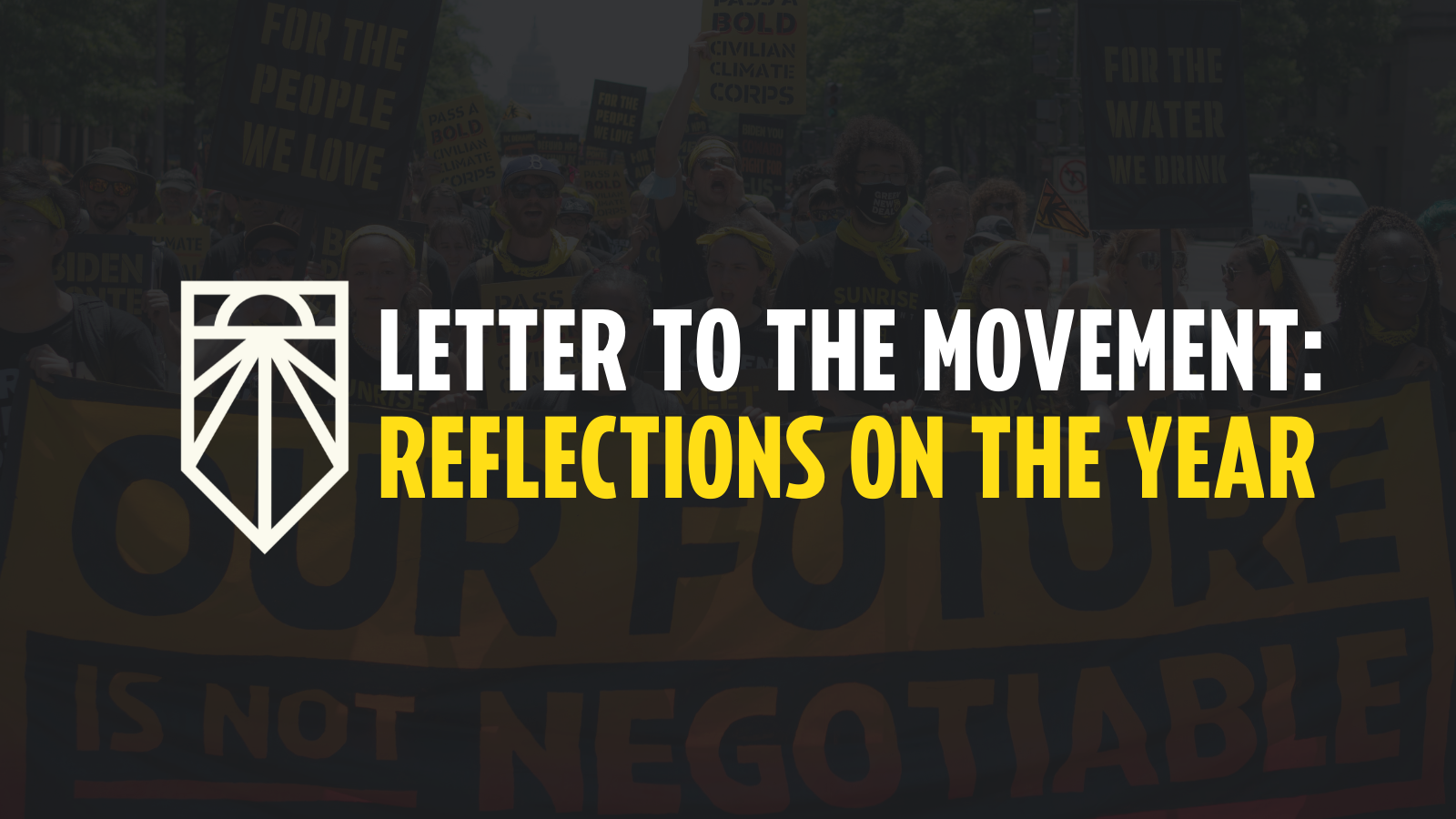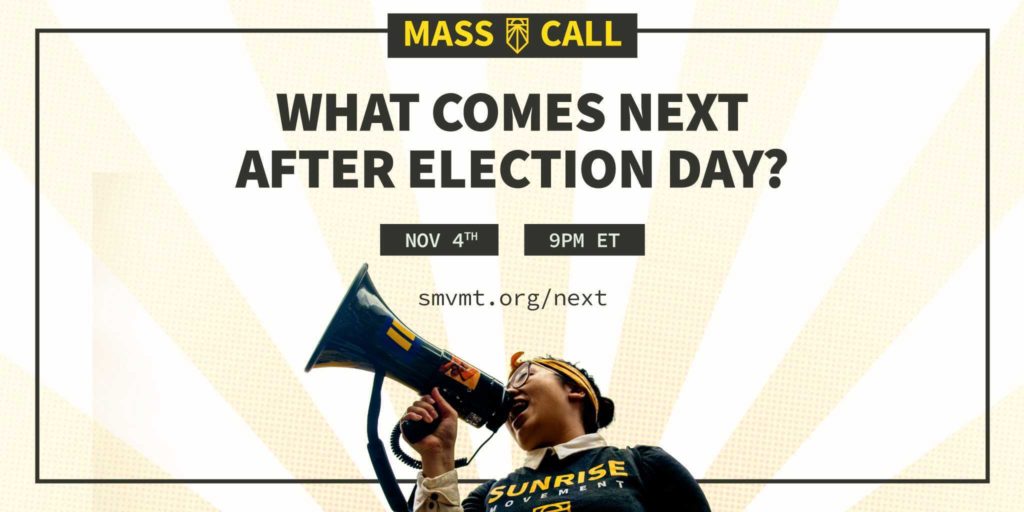To the Movement:
If you had told me five years ago that I’d be working on a campaign to get the federal government to spend billions of dollars on a climate and jobs program, I wouldn’t have believed you.
When I joined Sunrise in 2018 during my junior year of high school, I couldn’t imagine what real climate solutions looked like. The Green New Deal didn’t exist yet, and the connection between climate and jobs was far from mainstream. Politicians were still debating whether climate change was even real, and everyone said combatting the climate crisis meant losing jobs. I was a young person who understood the stakes of the crisis, but felt powerless to stop it. Sunrise anchored me in a community of young people who fiercely believed that if we organized our generation, we could change the course of human history. The government could create millions of good jobs combatting the climate crisis, invest in our communities, and ensure a livable future. Sunrise gave me hope and something to fight for.
For the past five years, our movement has worked hard to organize our generation and build popular support for the Green New Deal. From occupying Nancy Pelosi’s office in 2018, to sitting in at the DNC, and showing up at politicians offices everywhere, we’ve made the climate crisis an urgent priority across America.
In 2020, young people mobilized to defeat Trump and elect Green New Deal champions. We forced Democrats to run on a bold climate agenda, and then voted in record numbers to deliver them control of the White House and Congress. And in 2021, when they were sworn into office, we knew we’d have to fight to turn their campaign promises into real legislation.
In Congress, it’s clear we’ve changed the conversation on climate. The idea that the government can create millions of good jobs to stop the climate crisis is now a common sense solution in the halls of power and climate is the center Biden’s agenda. Five years ago, that would have been unimaginable.
ORGANIZING WORKS
After a challenging year, facing COVID and the threat of a second Trump presidency, 2021 launched with a chance to swing big and win the climate and jobs legislation we’d dared to dream of for five years. Biden had just released the American Jobs Plan and included investments in climate jobs. The AJP was not ambitious enough on it’s own, but we knew winning legislation this year would open the door to even bigger policy in the coming decades.
I believed 2021 could begin the decade of the Green New Deal and finally end the fossil fuel era in America. With a generation of young people behind us and a Democratic majority who promised they’d have our backs, we got to work.
I was in a park in downtown Raleigh, North Carolina on April 7th during our first National Day of Action. With hub leaders from across the state and a coalition of NC based organizers, we marched to Thom Tillis’s office to demand he deliver Good Jobs for North Carolina. “WE ARE READY TO WORK” was painted on picket signs, not only in Raleigh that day, but in dozens of cities across America. April 7th became our movement’s largest day of action, and we were just getting started. The movement felt alive.
Soon after launching the “Good Jobs for All” campaign, we had real legislation to fight for (which later became part of Biden’s Build Back Better agenda). We backed a jobs program called the Civilian Climate Corps and other bills investing billions of dollars to cut carbon emissions. For the first time in decades, Congress had plans to invest historic amounts not only in climate, but also in health care, free college, and a child tax credit—all through Build Back Better.
In May, I walked alongside brave leaders like sixteen year old Chanté Davis, who instead of being in her junior year of high school, was trekking 400 miles from New Orleans to Houston for the Civilian Climate Corps. Hub leaders in California, the Gulf South, and Pennsylvania marched hundreds of miles last spring through communities most threatened by the climate crisis, demonstrating new levels of sacrifice, and inspiring our movement to fight for Build Back Better and the CCC. In fact, Sunrise and our partners made the CCC popular, cool, and even mainstream in the Democratic Party.
But despite having full control of the federal government, Democrats outside of the Squad were not fighting hard enough for the legislation on the table. In June, when Joe Biden was negotiating with Republicans and watering down his own plan, we knew it was time to go big. Calling on the hundreds of hub leaders who’d been organizing hard all year, we came together hundreds strong in Washington DC and blockaded all ten entrances of the White House. White House press secretary Jen Psaki herself responded to our powerful blockade, and we made sure climate remained the centerpiece of BBB.
All summer long, we pounded the drumbeat for Build Back Better and a Civilian Climate Corps. Sunrise LA Youth and Sunrise Tempe held three day sleep outs at the offices of Senators Diane Feinstein and Kyrsten Sinema. Sunrise NYC staged an escalated sit in and forced Senator Chuck Schumer to fight for a CCC. Hundreds of young people joined weekly meetings to call constituents in West Virginia and Arizona. In September, we hosted another day of action, and over 20 college students from George Washington University were arrested at the Dirksen senate office building in DC. We mobilized our movement, forced the House to hold the line as long as they could, and fought like hell for BBB to pass. And we were getting really close. Until Joe Manchin, Kyrsten Sinema, and other corporate Democrats cut the legislation in half.
Everyday, new information would fly through our chats: Manchin won’t support a 3.5 trillion dollar package…Biden is compromising again…BBB’s getting cut to 1.7 trillion…Progressives are still trying to hold the package together…Manchin says he won’t vote for it all…code red, Build Back Better is under threat.
In October, it was clear no one in Congressional leadership was brave enough to fight for all of Build Back Better. If Democrats didn’t have the courage, we needed to be brave for them. I was with my friends Kidus, Abby, Julie, Paul and Ema when they put their bodies on the line and started hunger striking for the climate and jobs legislation we needed to survive. Biden and Democrats needed to feel the urgency to act that our generation lives with everyday.
Kidus went to the hospital four days in. As we waited all night for updates on his prognosis, I wondered if in the end, any of this would be worth it. Was risking their lives worth billions of dollars to stop the climate crisis? Did the Democrats even care enough to fight for us, or were they too corrupted by their corporate donors? But when Kidus came back, I saw a fire in his eyes that gave me the strength to keep hoping. In spite of his rapidly declining health, he bravely continued the hunger strike because he understood Democrats failing to pass legislation this year meant losing our last chance to stop the worst of the climate crisis.
Kidus, Abby, Julie, Paul and Ema did not eat for two weeks to save Build Back Better and win 550 billion dollars in climate investments. We were able to keep the pressure up on Democrats, and we changed the narrative around the stakes for climate legislation, but in the end, it still wasn’t enough.
WHERE IS BUILD BACK BETTER NOW?
Build Back Better did not pass in 2021, and the truth is, it’s still in limbo in Congress. Joe Manchin is holding up the agenda of the entire Democratic Party, and his power over Build Back Better exposes how corrupt our political system is. Our generation is once again getting sold out to the fossil fuel industry because Manchin has chosen his coal factory profits over the lives of his constituents.
This year, we came within inches of winning historic climate investments. We are only one vote away from passing the legislation that gives our generation a fighting chance to survive, but without Joe Manchin’s support, it’s unlikely all of the pieces of BBB will remain in one passable package.
Because of our movement and our organizing, climate is the key part of the bill that might be passed on its own. If it passes, it will be a direct result of our actions and continuous pressure to go big on climate. We should be proud of making climate a topline issue for the Democratic Party, we’re proud of the hub members who are still pushing for BBB, but even if a small climate bill eventually passes, we deserve more from the politicians we put in office.
We deserve pathways to citizenship, real investments in climate and jobs that match the scale of the crisis, better healthcare, and childcare. We’ve given everything to lay the groundwork for the Green New Deal and make the Civilian Climate Corps a reality—not just through this campaign, but also through five years of hard organizing, changing the conversation on climate, and changing what is politically possible to achieve.
REAL TALK
In an alternate world, I’m a junior in college right now. My days are spent studying, hanging out in dorm rooms, and playing frisbee on the Quad. I chose to organize full time with Sunrise because I want to survive and I know time is running out.
I led with many emotions throughout this campaign, but mostly I approached Good Jobs for All and Build Back Better from a place of hope. I believed wholeheartedly in our movement: the people power we had in the streets, the political power we built in Congress, and the strength we had to finish what we started. After years of enduring the Trump presidency, facing a global pandemic, and feeling the climate crisis get worse, winning legislation in 2021 felt inevitable.
Build Back Better didn’t die on some noble hill or in a dramatic debate one night — it died painfully slow in closed door meetings and sucked the life out of the movements that fought so hard to keep it alive. I’ve spent the winter hibernating in my thoughts, trying to make sense of how close we got, how much we have to be proud of, and grieving the loss of not having legislation yet.
The first Sunrise shirt I ever purchased in 2018 says “12 Years” in bright yellow font. It represents the time we have left to make a meaningful intervention on the climate crisis. In the three years since it was printed, our movement has changed the conversation on climate and built real political power, but we still have more work to do if we’re going to curb emissions and have a livable future. Twelve years used to feel like a long time. Now, I see our window of opportunity is running out.
The climate crisis is already at our doorsteps. Last year, millions of Texans faced weeks-long power outages in freak freezing conditions when our fossil fuel run energy grid failed. Hurricane Ida brought record rainfall to the Northeast, and dozens of people drowned in their own homes in New York, Pennsylvania, New Jersey, and Connecticut. 1,000 homes burned to the ground in Boulder, Colorado this December. As our window to act gets shorter and the climate crisis gets stronger, I’m increasingly haunted by the passage of time and the fear that the government will never do enough.
When I find myself pulled deep into cynicism, I look to this movement for support. Young people like Chante, Kidus, and Abby remind me how strong our movement is. We’ve given everything to make the Civilian Climate Corps and the first parts of the Green New Deal a reality, and I’m so proud of this movement for showing up when it mattered most. We poured our bodies, souls, and hearts into this campaign. I’m grateful for the hope we fiercely held through the end.
We haven’t yet won the legislation we need to survive, but we’ve opened the door and pushed forward excitement for federal jobs programs and visionary climate action. I will be living through the climate crisis for the rest of my life, and the path ahead goes straight through the storm. We got closer than ever before to winning real legislation, and I know we must keep building power.
At the end of February, I joined our team in Texas to canvass for Jessica Cisneros. Talking with voters in Laredo and San Antonio, it’s clear communities are ready to get to work winning a Green New Deal. Corporate politicians like Henry Cuellar have stood in the way of our dreams for too long. This year, I’ve questioned our ability to win governing power, but as election results started rolling in on Tuesday night in Laredo, I could feel it in the air: hope. In South Texas, Jessica Cisneros has changed the game, and this is just the beginning. 250 miles north in Austin, fellow Green New Deal champion Greg Casar won his congressional primary in a resounding victory.
As we move into 2022, I’m excited about the slate of Green New Deal champions running for Congress across the country. The fight for Build Back Better came down to one or two votes in the Senate, and has shown that we need more progressives from and for their communities to have our backs and help turn our big, visionary demands into real policy.
We always knew the Green New Deal was more than one bill or piece of legislation, and the campaign for Build Back Better and a Civilian Climate Corps was just the start in a decades long fight for our communities.
With gratitude, love, rage, and cautious optimism,
Audrey Lin (she/her, 20 years old), 2021 Campaign Team Manager





